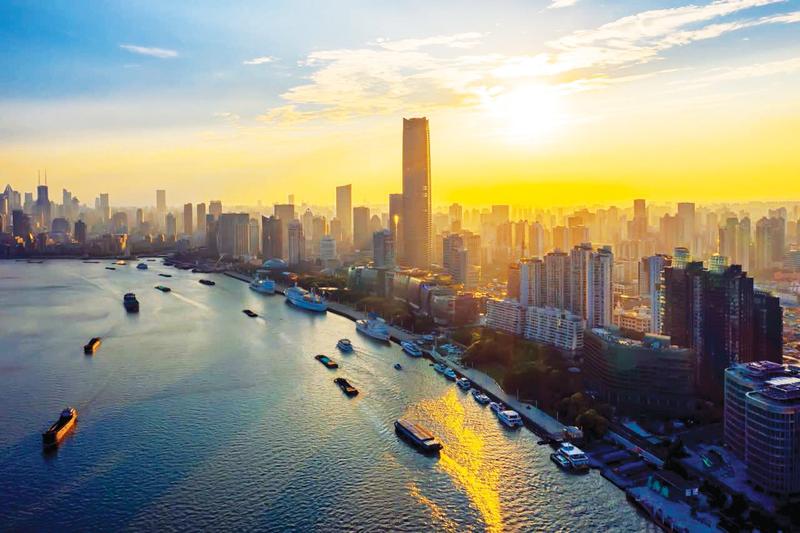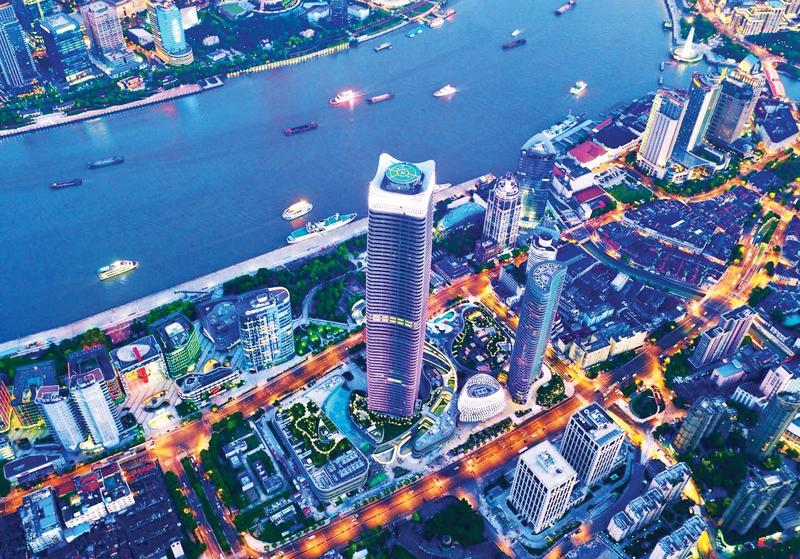 Shanghai’s North Bund area is set to become the next commercial hub in the city. (PHOTO PROVIDED TO CHINA DAILY)
Shanghai’s North Bund area is set to become the next commercial hub in the city. (PHOTO PROVIDED TO CHINA DAILY)
Change is constantly taking place in Shanghai, and one of the areas currently undergoing the most extensive of developments is the North Bund.
Located in the city’s Hongkou district where the Suzhou Creek and Huangpu River meet, the North Bund has long been a hub for the international shipping industry.
Presently, the 4-square-kilometer area is the largest redevelopment zone in downtown Shanghai following the release of a master plan by the municipal bureau of planning and land resources. The bureau now aims to further unlock the area’s potential as a commercial district.
According to Wu Xinbao, secretary of the Hongkou district committee, the North Bund will become “a new benchmark for urban development in the new era, a core engine and a landmark for the city’s development”.
To achieve this goal, the North Bund Development and Construction Expert Committee was established. Zhang Junjie, dean of the East China Architectural Design and Research Institute, and Sha Yongjie, executive deputy director of Architecture and Urban Space Research Institute of Tongji University, have been appointed as chief planner and architect respectively.
Based on the plan, the area will be divided into three zones: the central business zone comprising office buildings and commercial facilities, the Tilanqiao zone in the east and the Hongkou port zone in the west where historical and cultural elements will be restored.
“In line with international standards, we will strengthen global resource allocation and optimize the business environment in the area, building it into a central region for global headquarters and a meeting room for the world,” Wu told Shanghai Media Group in an interview in January.
The surrounding 60,000 square meters of parkland and more areas in the North Bund area will also be opened up for commercial development this year. The region will feature over 200 office buildings aimed at attracting global enterprises to set up regional headquarters, space for conventions and events, and a grand theater with more than 2,000 seats.
A 480-meter skyscraper, which would become the tallest building on the western bank of Huangpu River, and two other buildings measuring 380 and 320 meters in height, will also be constructed in the region.
The North Bund — the place where the city’s shipping industry was birthed when the first harbor was established by the British East India Company in 1845 — is presently home to about 4,600 shipping companies such as COSCO Shipping, nearly 1,800 domestic and international financial enterprises, one-eighth of China’s mutual funds and about US$900 billion in assets under management.
As of December 2020, the area has introduced 279 key projects with a registered capital of over 30 million yuan (US$4.62 million). These projects make up nearly 120 billion yuan in investments.
 Shanghai’s North Bund area is set to become the next commercial hub in the city. (PHOTO PROVIDED TO CHINA DAILY)
Shanghai’s North Bund area is set to become the next commercial hub in the city. (PHOTO PROVIDED TO CHINA DAILY)
Authorities said that they are planning to introduce more leading global financial institutions and shipping enterprises, as well as further develop financial services in multiple fields including asset management, equity investment and venture capital.
Meanwhile, access to every corner of the city from the North Bund will be enhanced by a renovated transport network that includes new metro lines and bus stops. In addition, 11 blocks spanning 0.5 square kilometers will be designated as “slow zones” where cars share the pathway with pedestrians and cyclists. There will also be an underground parking area that would help alleviate traffic pressure.
Despite the focus on transforming the area, the development plans for the North Bund includes efforts to preserve its history, which can be traced back to 1843. The area used to be a wartime sanctuary for some 20,000 Jewish refugees fleeing Europe from 1933 to 1941 during the Nazi era.
Cultural landmarks, including the Memorial for the Site of the Fourth National Congress of the Party in Shanghai, are currently undergoing renovation.
The renovated Shanghai Jewish Refugees Museum, which is located on the site of the former Ohel Moshe Synagogue that was built in 1927 in Hongkou district, reopened its doors to the public in December with an exhibition area four times larger than before. The refurbished museum now has new function halls, educational facilities and nearly 1,000 exhibits.
Clusters of shikumen, a Shanghai architectural style featuring Western and Chinese elements, in the area have also been preserved.
According to the plan, the North Bund and its surrounding areas will accelerate the renovation and maintenance of historic architectures as well as introduce 17 high-quality modern residential buildings neighborhoods to achieve a blend of the contemporary and the traditional.
In terms of education facilities, 10 kindergartens and seven primary and secondary schools will be built over the next five years. Medical and healthcare services will also be strengthened.
“In the past two to three decades, the construction of the economic centers in downtown Shanghai was mainly focused on commercial functions, whereas this plan has more emphasis on people’s lives,” Wu Jiang, the executive vice-principal of Tongji University who participated in the formulation of the plan, was quoted as saying to local online platform Houkou Cultural Cloud in April last year.
Zhou Changqing, a board member of Beijing-based commercial real estate service provider RET, echoed this sentiment, noting that the master plan is focused on achieving a balance between work, life and the environment, something which will likely be the standard approach the government takes for similar developments in the future.
Technology-wise, the North Bund is expected to become one of the world’s first areas with 5G coverage and superfast broadband. Since its launch in 2019, the 5G global innovation hub situated in the eastern part of the North Bund has become a hub where various 5G infrastructure scenarios related to telemedicine, online education, and naked-eye 3D displays are being piloted.
As of April 10 last year, the science and technology commission in Hongkou district had introduced 41 5G companies and 41 traditional information service companies.
“Every building in the area will be smarter and safer than ever, making Shanghai a 24-hour city,” Wu Xinbao of Hongkou district said.


